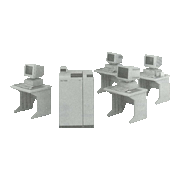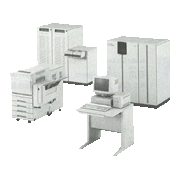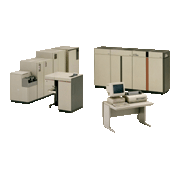NEC began selling, as the Parallel ACOS series, the compact AX7300 in May 1994 and the mid-sized PX7500 in July. NEC added the PX7800 in December 1994 to round out the large and ultra-large machine range. The aim of the Parallel ACOS series was to provide high-performance, mainframes at low cost by connecting multiple single-chip CMOS processors in parallel using the ACOS architecture. Other goals were to continue support of existing software resources, enhance open product interconnectivity, and provide flexible and scalable configurability.
For increased reliability, the AX7300 and the PX7500 used two single-chip NOAH-1 CMOS processors for redundancy with a mechanism that monitored the results of both. Memory access had a retry feature as a means of recovering from intermittent faults. The PX7800 ran on a NOAH-2 CMOS processor that packed the functions of an ultra-large mainframe into a single chip. A shared-memory CPU topology was formed by connecting as many as 16 of these processors. In turn, up to four of these shared-memory CPUs could be connected to form a parallel file-sharing system with 64 processors. The NOAH-2 chip had enhanced RAS functions built in, such as parity-bit fault detection, software instruction retries, and processor relief functions.
| AX7300 | PX7500 | PX7800 | |
|---|---|---|---|
| Processor | NOAH-1 | NOAH-1 | NOAH-2 |
| EPU construction | Two NOAH-1 processors with cache memory |
Two NOAH-1 processors with cache memory |
Single-chip EPU |
| Max. number of EPUs | 4 | 4 | 16 |
| Max. main memory capacity | 224MB | 512MB | 2GB |
| Max. number of channels | 48 | 96 | 256 |
| Max. total transfer speed | 160MB/s | 320MB/s | 1GB/s |




